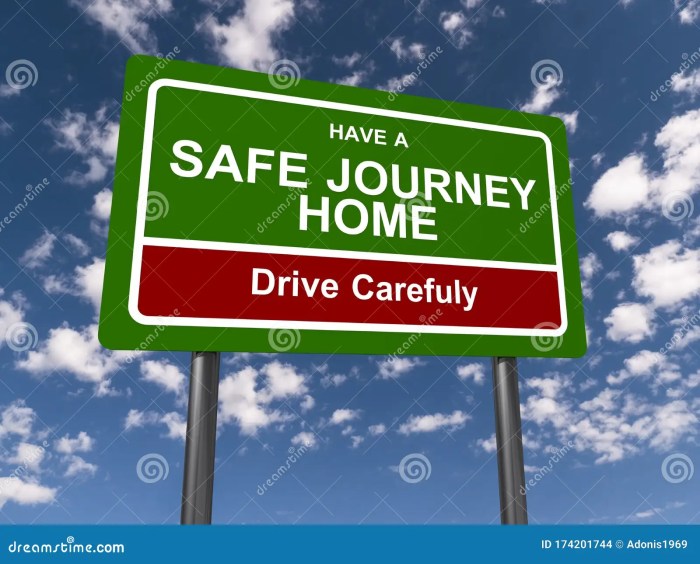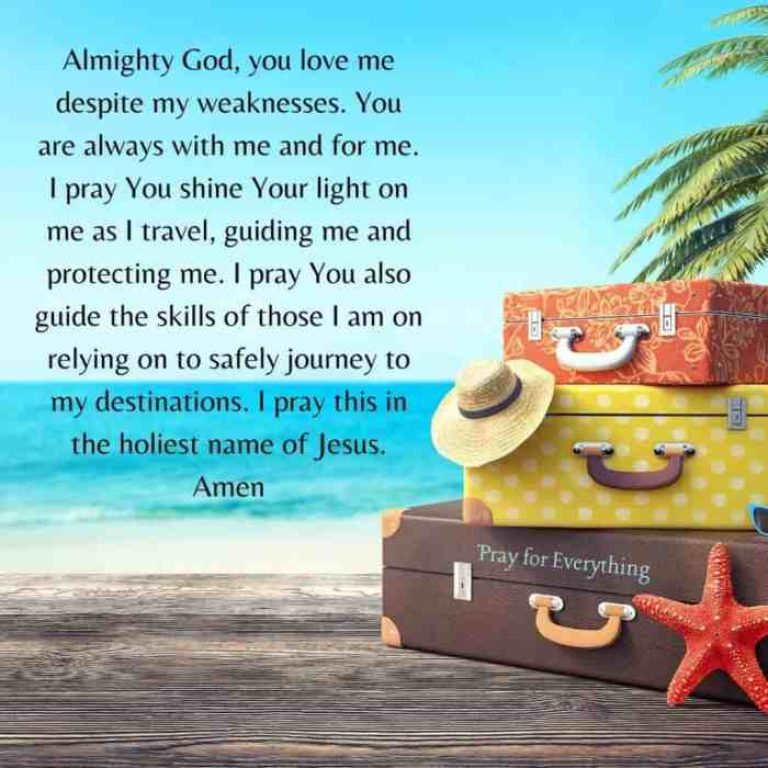Safe travels meaning goes beyond a simple farewell; it’s a heartfelt wish encompassing safety, well-being, and a smooth journey. This phrase, commonly used before departures, carries a deeper significance depending on context, ranging from a quick, informal goodbye to a more profound expression of care for someone embarking on a significant trip. We’ll explore its literal and symbolic interpretations, cultural variations, and even its portrayal in various media.
From the mundane commute to a life-changing adventure, “safe travels” carries weight. We’ll unpack how the phrase’s meaning shifts depending on the mode of transport (plane, train, automobile), the formality of the situation (a casual chat versus a formal send-off), and cultural norms. We’ll also delve into the practical safety aspects, offering advice on ensuring a secure trip, and the emotional resonance of the phrase for both the traveler and those left behind.
Safety Aspects Implied by “Safe Travels”: Safe Travels Meaning

Safe travels encompass much more than just arriving at your destination without incident. It involves proactively mitigating a wide range of risks to ensure a positive and worry-free experience. This means considering various potential hazards and taking appropriate steps to minimize your vulnerability.
Travel, by its very nature, exposes individuals to a heightened risk of accidents, illnesses, and theft, among other potential problems. These risks can vary significantly depending on the destination, mode of transport, and the traveler’s personal circumstances. Understanding these risks and preparing accordingly is crucial for safe and enjoyable travel.
Types of Travel Risks
Travel risks are diverse and can broadly be categorized into accidents, illnesses, and security concerns. Accidents can range from minor injuries like sprains to serious incidents involving vehicles or natural disasters. Illnesses, from mild food poisoning to more serious infections, are another significant concern, especially in regions with different sanitation standards. Security risks encompass theft, scams, and even more serious criminal activities.
These threats are not mutually exclusive; for example, a car accident could lead to injury and theft of belongings.
Precautions for Safe Travels
Taking proactive steps before, during, and after your trip significantly reduces the likelihood of encountering problems. Before you go, research your destination, understanding local laws and customs, and checking for any travel advisories or warnings. This research should include looking at potential health risks and necessary vaccinations. Packing appropriately is also crucial, including essential medications, copies of important documents, and appropriate clothing and gear for the climate and activities planned.
During your trip, be aware of your surroundings. Avoid walking alone at night in unfamiliar areas, and be cautious about who you interact with. Keep valuables secure, and use reputable transportation services. Stay hydrated and eat at established restaurants to minimize the risk of foodborne illnesses. Regularly back up important data and photos to the cloud.
Practical Safety Measures for Different Travel Scenarios
The specific safety measures you take should be tailored to your travel situation. Here’s a brief guide:
| Travel Scenario | Safety Measures |
|---|---|
| Solo backpacking | Inform someone of your itinerary, carry a personal locator beacon (PLB), be extra vigilant about your belongings, avoid risky situations, and learn basic self-defense techniques. |
| Family vacation | Ensure children are supervised at all times, use child safety restraints in vehicles, and teach children basic safety rules. Make copies of important documents and keep them separate from originals. |
| Business trip | Share your travel details with your company, be mindful of your surroundings, and avoid displaying expensive jewelry or electronics. Use secure transportation and accommodation. |
| Cruises | Be aware of the ship’s safety procedures, attend safety briefings, and familiarize yourself with emergency exits. Use the ship’s security services if you have concerns. |
Emotional and Symbolic Meaning of “Safe Travels”

The phrase “safe travels” carries more than just a simple wish for a journey free from accidents; it embodies a profound emotional depth, particularly when said to loved ones embarking on long or significant journeys. It’s a sentiment woven with concern, hope, and a silent acknowledgment of the vulnerability inherent in venturing into the unknown.The symbolic weight of “safe travels” extends beyond physical safety.
It represents a wish for overall well-being throughout the trip. It encompasses a hope for smooth sailing, positive experiences, and a successful outcome to the journey’s purpose, whether it’s a business trip, a pilgrimage, or a long-awaited vacation. It’s a blessing, a silent prayer for protection and a positive experience.
A Narrative Illustrating the Emotional Impact of “Safe Travels”
Imagine a young woman, Anya, leaving her small town for the first time to study abroad in a far-off country. The day of her departure is bittersweet. Her parents, usually stoic, are visibly emotional. Her father, a man of few words, simply says, “Safe travels, Anya.” Those three words, delivered with a choked-up voice and a firm grip on her hand, resonate deeply.
They aren’t just words; they’re a tangible expression of his love, his pride, and his unspoken fears for her well-being. For Anya, they are a source of comfort and strength, a silent promise of unwavering support, carrying her through the anxieties of leaving home and embracing a new adventure. Conversely, saying “safe travels” to Anya allows her father to express his love and concerns in a way that transcends the limitations of words, offering both a blessing and a comfort.
The simple phrase becomes a powerful symbol of their bond and his unspoken hope for her safe return.
Safe Travels in Different Media
The phrase “safe travels” transcends simple well-wishes; its meaning deepens depending on the context of its use. Examining its appearance in literature, film, and song reveals how this seemingly straightforward expression can carry profound emotional weight and symbolic significance, reflecting the anxieties and hopes associated with journeys and departures.The use of “safe travels” varies significantly across different media. In literature, it can serve as a poignant farewell, a subtle foreshadowing, or a symbolic representation of the characters’ inner emotional state.
In film, the phrase can be visually underscored with imagery that enhances its meaning, while in song, it often forms part of a broader narrative about parting, adventure, or the uncertainty of the future.
Examples of “Safe Travels” in Various Media, Safe travels meaning
The following table provides specific examples of the phrase “safe travels” across different media types, illustrating the diverse ways in which it is employed and interpreted.
| Media Type | Example | Context | Interpretation of “Safe Travels” |
|---|---|---|---|
| Literature | (Hypothetical Example) In a fantasy novel, a departing knight is given the blessing “safe travels” by his queen. | The knight embarks on a perilous quest to defeat a dark sorcerer. | The queen’s wish conveys not only a hope for the knight’s physical safety but also a deeper wish for his successful return and the triumph of good over evil. It’s a blessing imbued with hope and anticipation. |
| Film | (Hypothetical Example) In a dramatic film, two estranged lovers exchange a silent nod, and one utters “safe travels” before the other departs on a long journey. | The lovers are separating due to circumstances beyond their control, leaving their future uncertain. | The phrase here acts as a bittersweet farewell, highlighting the unspoken emotions and unresolved feelings between the characters. It is tinged with both hope for their future and the sadness of separation. |
| Song | (Hypothetical Example) In a folk song, a departing traveler is wished “safe travels” by their loved ones. | The traveler is leaving their home to seek fortune or escape hardship. | The song uses “safe travels” to create a sense of both longing and anticipation. It frames the journey as a significant event, potentially fraught with danger, but also full of potential. The wish serves as a poignant reminder of the bonds between the traveler and their community. |
| Video Games | (Hypothetical Example) In a role-playing game, a non-player character (NPC) says “Safe travels, adventurer!” as the player character sets off on a quest. | The player character is embarking on a potentially dangerous quest to defeat a boss or complete a mission. | In this context, “safe travels” acts as an encouraging message, implying a wish for success and survival. It establishes the game’s narrative, and subtly underscores the dangers the player character will face. |
Visual Representations of Safe Travels
Visual representations of safe travels often aim to evoke feelings of security, comfort, and the promise of a smooth journey. They utilize color palettes, symbolic imagery, and overall composition to convey a sense of peace and reassurance to the viewer. These visuals can range from simple icons to complex illustrations, each carrying its own unique message.A compelling visual representation of safe travels could depict a stylized compass nestled within a protective circle, perhaps formed by intertwining branches or a stylized sunburst.
The compass, pointing resolutely towards a distant horizon, symbolizes guidance and direction. The protective circle suggests safety and security, shielding the compass from potential dangers. The color palette could be predominantly blues and greens, evoking feelings of calmness and serenity, with accents of gold or bronze to highlight the compass and suggest warmth and reliability. The overall mood would be one of quiet confidence and hopeful anticipation.
Symbolic Imagery in Visual Representations of Safe Travels
Different visual elements contribute significantly to the overall message of safety and smooth journeys. The effective use of these elements enhances the visual narrative.A compass, as mentioned, represents guidance and a clear path. A well-drawn map, possibly slightly aged to suggest a sense of tradition and reliability, could show a clearly marked route, highlighting the journey’s destination and suggesting a planned and well-prepared trip.
A protective amulet, perhaps a stylized bird in flight or a stylized shield, would directly convey the idea of protection from harm or unforeseen circumstances. The inclusion of a sturdy vehicle, such as a ship sailing on calm seas or a train smoothly traversing a landscape, could further reinforce the idea of a safe and comfortable journey. The use of bright, clear skies and sunlit landscapes would also add to the feeling of a positive and secure journey.
Ultimately, the meaning of “safe travels” is multifaceted. It’s a simple phrase with profound implications, a blend of practical concern for safety and a deeper wish for well-being and a successful journey. Whether spoken casually or with heartfelt emotion, it serves as a potent symbol of care and hope for a positive travel experience. Understanding its nuances enriches our appreciation for this common yet significant expression.
Common Queries
What’s the difference between “safe travels” and “have a good trip”?
“Safe travels” emphasizes safety and well-being, particularly in potentially risky situations. “Have a good trip” is more general, focusing on a pleasant experience.
Is it appropriate to say “safe travels” to someone driving across town?
While not inappropriate, it might sound slightly over-the-top for a short, local journey. A simple “have a good day” or “drive safe” would be more fitting.
How can I make my travels safer?
Research your destination, share your itinerary, keep valuables secure, be aware of your surroundings, and follow local safety guidelines. Travel insurance is also a good idea.


